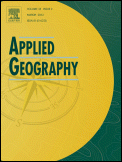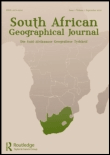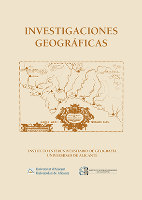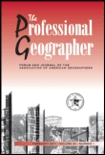
Geosaberes
Scope & Guideline
Exploring Interdisciplinary Perspectives in Geography
Introduction
Aims and Scopes
- Environmental Management and Sustainability:
The journal emphasizes studies related to environmental management and sustainability practices, particularly in urban and rural contexts. This includes research on the impact of human activities on ecosystems and strategies for sustainable resource use. - Geospatial Analysis and Technological Applications:
There is a strong focus on the application of geospatial technologies and methods, such as geographic information systems (GIS) and remote sensing, for mapping and analyzing geographical data. This methodological approach supports various research areas, including urban planning and environmental monitoring. - Community Engagement and Participatory Approaches:
The journal promotes participatory research methodologies that involve local communities in decision-making processes related to land use, resource management, and educational initiatives. This approach highlights the importance of local knowledge and active participation in geographic studies. - Cultural Geography and Identity:
Research on cultural geography, including the examination of social constructs, identities, and heritage within geographical contexts, is a core area of interest. This includes the exploration of how culture influences spatial practices and perceptions. - Educational Innovations in Geography:
The journal addresses pedagogical strategies for teaching geography, including the integration of technology and innovative educational techniques to enhance learning outcomes in geography courses.
Trending and Emerging
- Climate Change and Environmental Risks:
There is an increasing focus on the impacts of climate change and environmental risks, especially regarding urban areas and vulnerable communities. This trend underscores the urgency of addressing climate-related challenges in geographical studies. - Indigenous Rights and Land Management:
Research exploring the relationship between indigenous communities and land management practices is gaining prominence. This theme emphasizes the importance of integrating indigenous knowledge and perspectives into contemporary geographical discourse. - Urbanization and Sustainable Development:
The journal is witnessing a trend towards studies that examine the intersection of urbanization with sustainable development goals. This includes research on urban expansion, infrastructure development, and their environmental implications. - Digital Geography and Technology Integration:
Emerging themes include the use of digital tools and geospatial technologies for community mapping, social media analysis, and enhanced educational practices in geography. This reflects a broader trend towards incorporating digital methodologies in geographical research. - Health Geography and Environmental Education:
There is an uptick in research that connects health outcomes with geographical factors, as well as the role of environmental education in fostering awareness and action towards sustainability. This theme highlights the importance of geography in public health discussions.
Declining or Waning
- Traditional Land Use Practices:
Research focused on traditional land use practices has become less prominent, possibly due to a shift towards more contemporary issues such as urbanization and technological impacts on geography. - Historical Geography Studies:
There appears to be a waning interest in historical geography, particularly studies that focus solely on historical land use without integrating current implications or sustainability narratives. - Purely Theoretical Geography:
The journal has seen a decline in papers that focus on abstract theoretical frameworks with little empirical application. Instead, there is a growing preference for studies that bridge theory with practical applications. - Conventional Environmental Assessments:
Traditional forms of environmental assessments that do not incorporate participatory approaches or advanced technological tools are becoming less common, reflecting a shift towards more integrated and inclusive methodologies.
Similar Journals

APPLIED GEOGRAPHY
Advancing knowledge for a sustainable geospatial future.APPLIED GEOGRAPHY, published by Elsevier Science Ltd, stands as a premier journal within the fields of environmental science, geography, planning and development, as well as tourism, leisure, and hospitality management. With an impressive 2023 impact factor that reflects its high citation rates, this journal is ranked Q1 in several categories, underscoring its significance and influence in interdisciplinary research. Covering a broad range of topics from innovative environmental practices to spatial analysis and socio-economic factors affecting tourism, APPLIED GEOGRAPHY promotes insightful discussions and practical applications that are vital for advancing knowledge and practice in these fields. Researchers, professionals, and students will find the journal's rigorous peer-reviewed articles invaluable for staying informed about the latest trends and findings impacting the geospatial landscape. As an essential resource, APPLIED GEOGRAPHY aims to foster interdisciplinary collaborations and inspire scholarly dialogue, making it a cornerstone for those engaged in the study and application of geography across various sectors.

Anales de Geografia de la Universidad Complutense
Illuminating the Intersection of Geography and SocietyAnales de Geografia de la Universidad Complutense is a prominent journal in the fields of Geography and Urban Studies, published by Universidad Complutense de Madrid. With a rich academic tradition since its inception, this journal has been open access since 1981, ensuring that valuable research is readily available to scholars and practitioners alike. The journal holds a significant position within the academic community, reflected in its Q3 ranking in both Geography, Planning and Development and Urban Studies categories as of 2023, and it provides an essential platform for interdisciplinary research and dialogues on pressing geographical and urban issues. As part of the Scopus indexed database, it ranks #201 out of 279 in Urban Studies and #684 out of 821 in Geography, indicating its growing influence and relevance. Based in Madrid, Spain, the journal welcomes contributions that aim to advance knowledge, foster collaboration, and stimulate critical thinking in these dynamic fields.

Journal of Geovisualization and Spatial Analysis
Unveiling Earth’s Patterns Through GeovisualizationJournal of Geovisualization and Spatial Analysis, published by SpringerNature, is an influential open-access journal specializing in the cutting-edge fields of geovisualization, spatial analysis, and their application in earth sciences and geography. Since its inception in 2017, this journal has established a prominent stance with a high impact factor and prestigious Q1 rankings across multiple categories, including Computers in Earth Sciences, Earth and Planetary Sciences (miscellaneous), and Geography, Planning and Development. The editorial board is committed to advancing innovative research and methodologies, providing a platform for scholars to disseminate their findings globally. With impressive Scopus rankings—placing it in the top percentiles among its peers—the journal serves as a vital resource for researchers, professionals, and students keen on understanding spatial data and its implications for geographic science. Its emphasis on rigorous peer review and rapid publication enhances accessibility to substantive research, thus fostering knowledge sharing within the scientific community. Based in Switzerland, the journal promotes a collaborative environment for interdisciplinary studies, making it an essential read for anyone involved in spatial analysis research.

Bulletin of Geography-Physical Geography Series
Advancing the frontiers of physical geography.The Bulletin of Geography-Physical Geography Series is a prominent open-access journal dedicated to advancing the field of physical geography. Published by Nicolaus Copernicus University in Poland, this journal has been a vital resource for researchers, professionals, and students alike since its inception in 2009. With an ISSN of 2080-7686 and an E-ISSN of 2300-8490, it contributes significantly to the academic discourse in geography, planning and development, and geophysics, boasting a 2023 Scopus rank of #385 in Social Sciences and #84 in Earth and Planetary Sciences. The journal aims to disseminate innovative research and critical insights that address contemporary challenges in physical geography, making it a valuable platform for those seeking to contribute to or stay informed about the latest developments in the field. With its commitment to quality and accessibility, the Bulletin of Geography-Physical Geography Series plays a crucial role in fostering scholarly exchange and collaboration globally.

Revista Geoaraguaia
Advancing Knowledge in Human and Social SciencesRevista Geoaraguaia, published by UNIV FEDERAL MATO GROSSO, is an esteemed open-access journal dedicated to advancing research in the field of human and social sciences. Based in Brazil, this journal facilitates scholarly communication and fosters interdisciplinary approaches, exploring topics that encompass geography, sociology, and environmental studies. Although specific metrics like H-Index and impact factor are not listed, the journal is committed to providing a platform for innovative research that addresses pressing societal challenges. Researchers, academics, and students will find a rich repository of articles that not only contribute to theoretical frameworks but also enhance practical applications in various settings. By connecting local and global issues, Revista Geoaraguaia plays a crucial role in promoting academic discourse and advancing knowledge in the vibrant landscape of Latin American studies.

South African Geographical Journal
Fostering dialogue for impactful geographical solutions.The South African Geographical Journal, published by Routledge Journals, Taylor & Francis Ltd, is a leading scholarly platform dedicated to advancing research in the fields of geography, planning, and development. With an impressive history spanning from 1931 to 2024, this journal not only retains its relevance in the academic community but also proudly holds a Q2 rank in both Earth and Planetary Sciences and Geography, Planning and Development, marking it as a significant contributor to the scholarly discourse. The journal is ranked in the top 32% of its category within Scopus, affirming its stature among researchers and professionals. Although it currently does not offer Open Access, the journal provides a critical forum for the exchange of ideas, methodologies, and findings, encouraging dialogue that informs policy and practice in the geographical sciences. Readers can expect a rich variety of articles that encompass both theoretical and practical aspects of geography, making it essential for academics and practitioners alike.

Investigaciones Geograficas-Spain
Innovating geographical discourse from Spain to the world.Investigaciones Geográficas-Spain is an esteemed academic journal published by the Universidad de Alicante, dedicated to advancing the fields of geography, planning, and development as well as earth and planetary sciences. With its commitment to open access since 1983, the journal ensures that research is readily available to a global audience, facilitating knowledge dissemination and collaborative discourse. As reflected in its 2023 Scopus rankings, it holds a commendable position within the Q3 category in both Earth and Planetary Sciences and Geography, Planning and Development, making it a noteworthy resource for scholars and practitioners in these disciplines. The journal's scope encompasses diverse geographical research, aiming to address pressing environmental and societal challenges through empirical studies and theoretical advancements. By contributing to the knowledge reservoir from Spain and beyond, Investigaciones Geográficas-Spain serves as a vital platform for researchers, professionals, and students seeking to enrich their understanding of geographical phenomena.

PROFESSIONAL GEOGRAPHER
Elevating the Discourse in Geography and Earth SciencesPROFESSIONAL GEOGRAPHER is a prominent journal in the fields of geography and earth-surface processes, published by Routledge Journals, Taylor & Francis Ltd. With a rich history dating back to 1949 and continuing through 2024, it serves as a vital platform for researchers, professionals, and students to explore and disseminate groundbreaking research and insights within the geographical sciences. The journal holds a respectable impact factor, placing it in the Q2 quartile for both Earth-Surface Processes and Geography, Planning and Development as of 2023, highlighting its importance in these critical academic areas. The journal ranks #273 out of 821 in Geography and Planning and #70 out of 179 in Earth and Planetary Sciences on Scopus, reflecting its robust contribution to advancing knowledge in social sciences. Although it does not currently offer open access options, it still provides invaluable content that influences pedagogy and research in geography. Its comprehensive scope invites a wide range of geospatial topics, encouraging interdisciplinary dialogue and collaboration across the global academic community.

Revista Geografica de America Central
Fostering Innovative Research in Central America.Revista Geografica de America Central is a distinguished scholarly journal published by the UNIV NACL, ESCUELA CIENCIAS GEOGRAFICAS, focusing on the dynamic field of geography, particularly within Central America. Since its inception in 1974, the journal has championed the dissemination of open-access research, fostering collaboration and innovation among researchers, professionals, and students alike. With an evolving scope that reflects the region's rich geographical diversity, this journal serves as a vital platform for sharing empirical studies, theoretical advancements, and methodological discussions that enhance our understanding of Central America's unique environmental and socio-economic challenges. Although it has experienced various coverage periods, the journal remains committed to advancing geographic scholarship and supporting open academic discourse. Its open-access model ensures that essential knowledge is readily available to an expanding global audience, making it an invaluable resource in the field.

Geography and Sustainability
Empowering Change Through Cutting-Edge Sustainability Research.Geography and Sustainability is a prestigious, peer-reviewed journal published by Elsevier, focusing on the interdisciplinary fields of geography, ecology, and environmental science. As an Open Access publication since 2020, it aims to provide a platform for the dissemination of high-quality research that addresses critical sustainability challenges facing our planet. Based in China, the journal navigates through an impressive array of categories, all classified in the Q1 Quartile rankings for 2023, showcasing its top-tier status in areas such as Earth-Surface Processes, Geography, Planning and Development, and Nature and Landscape Conservation. With its notable impact factors—ranked 2nd in Earth and Planetary Sciences and 3rd in Environmental Science—it attracts contributions from leading experts and emerging scholars alike. Researchers, professionals, and students seeking to advance the scientific understanding of sustainability and its geographical implications will find indispensable resources and innovative findings within the pages of this journal.